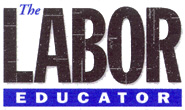American Labor in Crisis (July 23, 2007)
Labor Press Acts as Silent Collaborators
In AFL-CIO's Sham, Stacked Elections
(The third of five articles.)
By Harry Kelber
The current leaders of the AFL-CIO and the Executive Council have managed to get elected and re-elected four times, even though they have a deplorable record of organizing failures and legislative defeats. How do they do it? By having tight control of a majority of the convention votes so that it is impossible for any candidate to challenge them.
They hold sham elections in which the outcome has been decided long before the convention takes place. The 44 members of the policy-making Executive Council are "elected" en masse in a ritual that takes less than five minutes. All that is required is a reading of a list of their names and union affiliations before they are assured of a four-year term, without even opening their mouths to state their qualifications.
If the pattern established during the AFL-CIO's 50-year history is followed, the same national leaders will be re-elected at the 2009 convention, without any candidates to challenge them and with no criticism, debate or even comment from the many hundreds of delegates.
One would expect the labor press to expose these gross violations of union democracy and their negative impact on the lives of working families. It hasn't happened. In their coverage of AFL-CIO conventions, labor publications and labor radio, almost without exception, have consistently ignored the phony, stacked elections and thereby enabled these union leaders to maintain a hammerlock on the AFL-CIO.
AFL-CIO Leaders Use Trump Card to Maintain Their Power
The key to the dominating power of a small group of union presidents is the AFL-CIO Constitution, which grants international unions a total of convention votes equal to their reported membership, while it allots each affiliated state federation and central labor council a single delegate and one vote. This puts enormous power into the hands of international presidents while it downgrades state feds and CLCs to the level of convention wall flowers. Consider what happened at the AFL-CIO's 2005 convention:
• The United Auto Workers (as an example) had a total of 626,137 convention votes, so that each of its nine delegates could cast 69,437 votes for a candidate or policy issue. By contrast, the one delegate from the New York and California State Federations, each representing more than two million union members, had a single vote apiece,
• A small union like the Federation of Professional Athletes had 1,700 convention votes, based on its membership. This was more than three times the combined votes of the delegates from the 51 State Federations and 415 Central Labor Councils.
• In the AFL-CIO's 50-year history, no officer or member of a State Fed or CLC has ever been elected to the Executive Council or even had a fair chance of challenging the incumbents. The AFL-CIO has a frozen top leadership that operates as a self-serving, self-perpetuating oligarchy‹and it means to keep it that way.
There is a simple, effective way to rectify the manifestly unfair AFL-CIO convention voting system. It is to institute a procedure used by the U.S. Congress and virtually every bona fide organization in their elections and policy decisions. It provides that each delegate has one - and only one - vote. That is the democratic voting process also used by the Canadian Labor Congress. When AFL-CIO delegates attend a CLC convention, they abide by its rules.
Why 'One Delegate, One Vote' Is Urgently Needed
Here's why the reform of the convention's voting system is no petty matter:
"One Delegate, One Vote" restores the right of union members to be properly represented at conventions for the dues money they send the national AFL-CIO. Through their elected delegates, they will have a voice in determining the labor federation's policies and actions - rights that have been taken away from them.
To be successful, "One Delegate, One Vote" must have the active support of the labor media. They are the ones who can reach out to union members across the country to explain why convention reform is essential to their welfare.
But will the media respond to the urgent call for help? For the past several years, labor publications and labor radio programs have conspicuously avoided even mentioning "one delegate, one vote," largely from fear of antagonizing national labor leaders or being charged with disrupting "labor unity."
This will require a 180 degree turn for most publications and radio labor programs that have had a tacit policy of not attacking the AFL-CIO leadership.
Labor publications, their staffs and contributing writers can no longer duck the issue. They will either continue to refrain from criticizing the AFL-CIO's top leadership or they will support the reform of the convention voting system. If they remain silent, we will know where they stand.
Article 4 of “American Labor in Crisis” will appear on Monday, July 30, 2007. Also check our Web site: www.laboreducator.org

